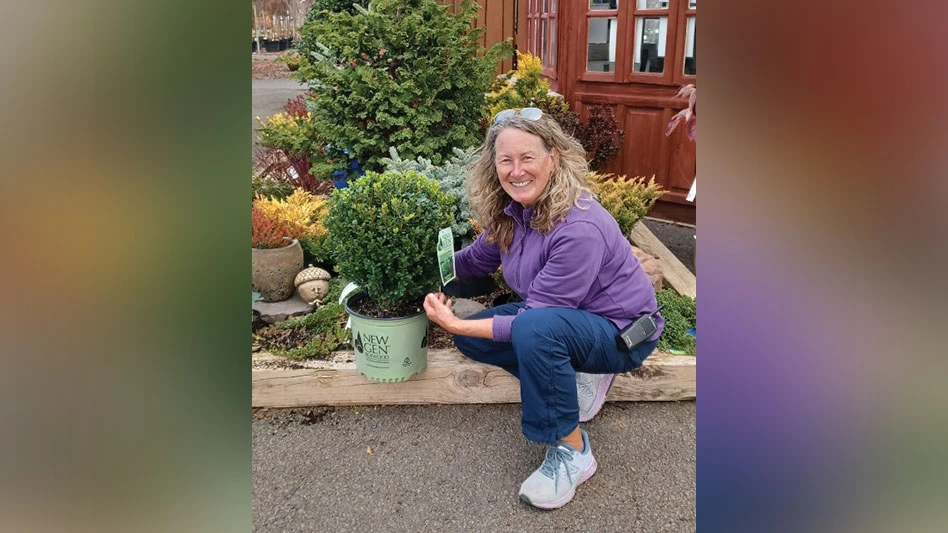Since 2001, the Garden Media Group has published its yearly Garden Trends Report, predictions of what will be popular in the industry for the coming year. The 2017 report, titled Grow 365, reflects innovations in indoor gardening technology combined with an increasing demand for clean food, making it more popular than ever to garden 365 days a year.
Grow 365 presented eight industry trends that inspire gardening year-round for its 2017 report.
The report emphasizes the clean food movement and how it is redefining indoor gardening for the modern age. Millennials especially demand to know where food comes from and what’s in it. Be sure and use the health theme for marketing ornamentals, as well. The report also reveals how consumers will want their gardens to look and how they’ll access information about growing plants.
1. Wellness hotspots


It is likely no surprise that many studies indicate time spent in nature reduces stress and increases well-being. From garden therapy and “forest bathing” to soundscaping and a green workplace culture, healthy is the new wealthy. Forest bathing is the “medicine of being in the forest” and spending time in nature awakening all five senses. Many people work indoors and don’t have time to immerse themselves in nature regularly, but research shows that indoor plants can create happier workers, lower healthcare costs, increase productivity, lower absenteeism and reduce turnover when placed on desks and office spaces. Studies examine how sounds – or the lack of sounds – indicate the ecological health of a landscape and the health of our lives. Our mental health, wellness and quality of life are directly affected by trees. Trees change everyday city sounds – from adding birdsongs to buffering sirens. The loss of trees changes the soundscape and decreases our quality of life, increases stress levels, affects our mental health and diminishes our ability to focus.
This applies at the workplace, as well. Ken Pelletier, a pioneer in workplace wellness, sees a shift from a goal of increased ROI to one of pursuing ROV (return on value) and creating a culture of wellness.
Indoor office plants create healthier and happier workers, lower healthcare costs, increase productivity, lower absenteeism and reduce turnover.
2. Tidy gardens
Tidy does not mean trimmed hedges and clean corners. It simply reflects a global shift toward reduced consumption coupled with finding bliss in what you do, not in what you have. This trend coincides with a downsizing trend as the U.S. population shifts from suburbs to city living in smaller spaces, and the demand for compact shrubs and container gardens grows.
3. Uber-izing gardening


Subscription services introduce people, especially millennials, to products they didn’t even know they wanted. The garden industry is poised to ride this rising trend. Likewise, more passionate gardeners can be introduced to new and exciting plants, products and tools they may never have thought to try. Garden services can range from seeds of the month and artisanal microgreens to heirloom bulbs and new plants. Delivering experiences comes in the form of regular workshops, too. These attract millennials who document experiences and devote discretionary income to these moments. Almost half of millennials splurge on classes to improve their body, mind and soul, and 65 percent indicated they would attend a class or workshop at a store to enhance their growing skills.
4. Buzz off!

Bats, birds and flowers are the best form of natural pest control. The zika virus scare and other mosquito-borne diseases combined with the demand to be chemical-free is driving people to look for ways to control pests naturally.
Barn swallows and purple martins can eat pounds of mosquitoes every day. Robins, mockingbirds, chickadees, nuthatches and woodpeckers are voracious insect eaters. Help consumers attract more bug eaters by encouraging them to plant flowers and trees that supply food and shelter.
5. Golden age

Gold is back in the spotlight, and its popularity in home décor, fashion and in the garden is expected to last a decade. When used outdoors, pops of gold warm up spaces and create the feeling of outdoor rooms.
When it comes to golden foliage, the garden just can’t have enough. Plants such as Katsura Japanese maple, The Rising Sun eastern redbud, carex and Goldy arborvitae will help the consumers’ garden glitter.
6. Redefining peak season

New technology can turn any kitchen counter into a vegetable garden. In 2015, indoor gardening and hydroponic stores made just under $1 billion. With the demand for organic, local food exceeding supply, and people choosing to live in smaller spaces and urban environments, more people will grow indoors. Research indicates 37 percent of Millennials and 28 percent of Boomers are growing herbs indoors. From growing arugula to bok choy, consumers want clean fresh food to be available to plant, pick and plate every season. From herbal tea gardens on the window sill and healing herbs under lights to vitamin-packed microgreens on the kitchen counter, medicinal gardens are gaining relevance.
The complete 2017 Garden Trends Report: Grow 365 is available for free download here: http://grow.gardenmediagroup.com/2017-garden-trends-report
Get curated news on YOUR industry.
Enter your email to receive our newsletters.

Explore the November 2016 Issue
Check out more from this issue and find your next story to read.
Latest from Nursery Management
- The Growth Industry Episode 3: Across the Pond with Neville Stein
- What's in a name?
- How impending tariffs and USDA layoffs impact the horticulture industry
- Shifting the urban environment
- These companies are utilizing plastic alternatives to reduce horticultural waste
- How to create a sustainable plant nursery
- Lamiastrum galeobdolon ‘Herman’s Pride’
- One of rarest plants on earth: Tahina spectabilis






